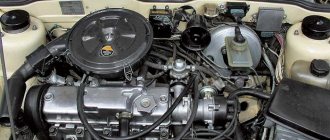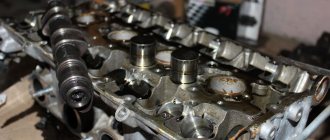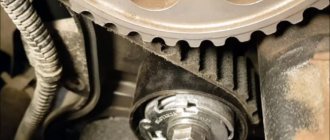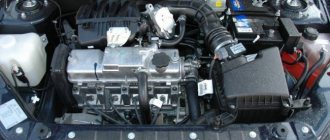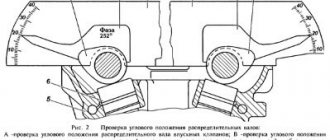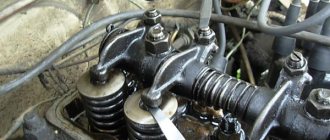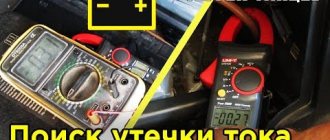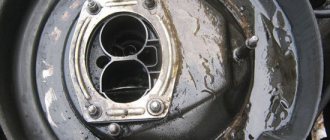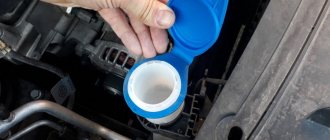The constant improvement of the internal combustion engine in order to increase efficiency and improve fuel efficiency has forced engineers to seriously rework the timing structure of modern diesel and gasoline engines. Changes also affected the design of the piston group and combustion chamber. These modifications were made to maximize the efficient filling of the cylinders and their high-quality ventilation, that is, to obtain improved gas exchange.
We also recommend reading the article about what a variable valve timing system is. From this article you will learn about what types of these solutions are installed on different engines, as well as the operating principles and design features of such systems.
If in the early stages of development the most common engine was with two valves per cylinder (1 intake and 1 exhaust valve), today an increase in the number of valves per cylinder is everywhere observed. Such changes are well illustrated by the most common version of the automobile internal combustion engine with four cylinders. Previously, such engines were often 8-valve, with one camshaft. Today, such a unit is often a 16-valve version with two camshafts (for intake and exhaust valves), can be equipped with a variable valve timing system, etc.
Why does the valve bend?
First, a little theory. The number of valves in an internal combustion engine can be different (up to 32), but we will consider 8 and 16-valve engines, of which 90% are on our streets.
Timing device
The valves serve to supply a combustible mixture into the cylinder and remove gases after the piston stroke. The camshaft controls their opening and closing. The latter, in turn, is driven by the crankshaft (in our case, by means of a belt). We will not go into detail about what gaps should be between the cams and how the depth of valve stroke affects the operation of the internal combustion engine. Just know: the intake and exhaust valves must open and close in strict accordance with the current engine stroke. Below we will leave a short video explaining the operation of the internal combustion engine.
If the drive breaks, the connection between the camshaft and crankshaft is lost. What's happening? The first shaft stops abruptly, the valves “freeze”. But the second one continues to rotate due to inertia. Accordingly, the pistons move upward. Reaching the top “dead” point, the piston bottom simply breaks the plate and stem of the stuck valve.
Consequences of a broken belt
This happens in each cylinder - somewhere to a greater extent, somewhere to a lesser extent. But there is only one outcome - the ejection valve. If, when the timing belt breaks, only the valves are replaced, congratulations! You are lucky. Usually it is necessary to carry out a major overhaul of the engine: the pistons, connecting rods, camshaft and even the cylinder head are replaced.
A non-obvious cause of bent valves is a jammed water pump. Some people simply forget about it when they change the timing belt. Yes, the pump lasts longer (120-200 thousand), but it still does not last forever. The best way to protect yourself is to replace the pump at the same time. If it jams, the engine will suffer a double blow - overheating and bending of the valves. There will be nothing to restore after this.
Failure to comply with maintenance regulations when servicing the timing belt can also cause valve bending. For domestic cars, the belt replacement schedule is 60 thousand kilometers. For foreign cars - from 90 to 180 thousand (but it is better to change at 90-120 thousand).
The belt is a consumable item, and over time it loses strength. The rubber becomes hard and cracks appear. The cord stretches and tears appear in places. All this increases the chances of the timing belt breaking (or at least jumping a couple of teeth).
Popular brands:
Hyundai Santa Fe, Toyota Camry, Volkswagen Passat
Causes of timing belt breakage
The most common reasons that lead to drive belt breaks are the owners' failure to comply with the manufacturer's replacement instructions. When the car is new and under warranty, the owners very rarely look under the hood - all maintenance work will be performed by the official dealer. When the warranty ends, many people try to save money by replacing the belt.
Often the pump can fail. In many car models it is driven by the timing belt. If the pump fails, the system will jam and the belt will wear out in a few hours. Also one of the most popular reasons is poor quality belts. Therefore, it is better to purchase high-quality and original consumables.
Camshafts and tension rollers of the timing mechanism may also fail. The latter fall off or may jam - the belt either flies off the gears or breaks. This is why the valves on the VAZ were bent.
Not only a break can happen to the belt. Often the teeth are cut off, and they are not so easy to detect. The teeth may slip if the tension roller spring is broken. On some engines, the camshaft gear has a special conical fit. Only a tightened bolt serves as insurance against gear rotation. If you do not reach it, then there is a risk that the gear will turn, and as a result, the valves will bend. Replacement is the only way out of the situation.
Why do valves bend on some cars and not on others?
How many times have owners argued about whether a valve bends or does not bend when the timing belt breaks. On the same model, with the same engine, they can break if broken or remain intact. It's all about the pistons.
This is what a Priorovsky piston looks like, which does not bend the valve
As you can see, the bottom may have a recess. The latter can be separate for each valve, or single (one recess along the contour). Such pistons were installed on VAZ engines, and were also found on Koreans and Japanese. Now, alas, you can’t find such a piston...
And all because the notches affect the efficiency of the engine. All things being equal, such an engine will produce less power and consume more fuel.
Belt drive failures
- belt break . Can be caused by wear, as well as excessive tension and wear on the tension and parasitic rollers; belt slippage due to cutting of teeth or breakage of the tension roller spring (if it is provided for in the design). Cut teeth may not be immediately detectable; cutting off one of the gear keys or breaking the keyway; On some engines, the camshaft gears have a conical fit, that is, only the tightening torque of the bolt serves as insurance against gear rotation. (One master failed to get such a gear. To my question: “So what?” was the answer: “twelve out of sixteen.” This meant bent valves, of course.)
How to find out if the valves on your car are bent
To find out which engines do not bend the valves and which ones do, check the model of your internal combustion engine. Below is a table containing information for each engine.
Consequences of a broken belt
You can check the probability of bending with your own hands. To do this, you need to set the piston to TDC and rotate the camshaft (two full turns). If the shaft moves with difficulty, it means that it rests on the valve and will break it if the belt breaks.
Belt drive failures
- belt break . Can be caused by wear, as well as excessive tension and wear on the tension and parasitic rollers;
- belt slippage due to cutting of teeth or breakage of the tension roller spring (if it is provided for in the design). Cut teeth may not be immediately detectable;
- cutting off one of the gear keys or breaking the keyway;
- On some engines, the camshaft gears have a conical fit, that is, only the tightening torque of the bolt serves as insurance against gear rotation. (One master failed to get such a gear. To my question: “So what?” was the answer: “twelve out of sixteen.” This meant bent valves, of course.)
How to understand that the valve is bent
If the timing belt comes off or breaks, the engine will immediately stall. It won’t even occur to most people that the problem is serious. Well, it stalled, so I’ll start it again and go. It is important to listen to the engine here. If the starter rotates faster than before, there is no need to turn the key any more - the belt is definitely torn. Well, it’s better to open the hood and look under the casing.
A belt that is already “on the verge”
If the casing is tightly screwed on, you can go the other way - unscrew the oil filler cap and check whether the camshaft cams rotate when starting (of course, you can’t do this without an assistant).
Unknowing drivers crank the starter until the last moment in the hope that the engine will start. At this time, the pistons simply chew through all the valves in turn. Therefore, if the car suddenly stalls, we look under the belt cover or at the first start, when we hear the “free flight” of the pistons, we immediately turn off the engine. Listen to how an internal combustion engine starts with a broken belt in the video.
Now about the valves. It doesn’t always bend them, but sometimes only a part breaks. This can be determined by measuring compression. At the slightest bend of the plate, the compression sags greatly. Such a motor can even start, but it works extremely unstable - it stalls.
There is another way to check:
- a piece of thick hose 5-10 centimeters long is selected (the diameter must correspond to the spark plug well);
- the spark plug is unscrewed, the piston is set to the TDC position (at this moment the intake and exhaust valves are completely closed);
- a hose is installed and air from the compressor is pumped inside.
If the valve is bent, the consequences will be heard. The air will go either into the inlet or out the outlet (depending on which rod is broken). And sometimes the air goes both ways. Experienced mechanics advise disassembling the head and doing a complete troubleshooting. After all, it is unknown how badly the rods were bent, whether the guides were damaged and whether the pistons were intact. This is the safest and most accurate way.
Easy way
First, let’s remember at what speed the engine suddenly stalled. Whether you were driving along the highway or standing at a traffic light, a lot depends on this.
If the engine was running at idle or at speeds less than 2000 rpm, then most likely there was no bending. If the engine was running at speeds above 2500 rpm and suddenly stalled while driving, then the valves were bent 100%. In general, for a more accurate diagnosis, it is still better to disassemble and check the motor.
If we are dealing with the first case, then we set the shafts according to the marks, put on a new belt and try to measure the compression. If it is positive in all cylinders, then the valves are not bent. And if they are low, then engine disassembly is inevitable.
Photos taken from the Internet!
What to do if it’s still bent?
In such situations, disassembly and troubleshooting must be performed. It is necessary to check thoroughly, because the consequences may be different. Some get off with a “slight fright” and change a couple of valves, others go through the entire engine. By removing the cylinder head, the full picture will be visible. If there is no damage to the pistons, you can only replace the valves and guides (of course, install new gaskets, oil seals, and oil seals).
The piston is damaged - just replace it!
If a defect is found on the piston bottom, you need to climb inside and check the connecting rod. All damaged parts must be replaced with new ones. No makeshift valve alignment! Ditch the engine and lose even more money.
Have you ever had any cases of bent valves? What consequences did you encounter and how did you repair it? Share your experience in the comments, write useful tips, and don’t hesitate to ask your questions. We invite everyone to discuss the topic!
Studying technical documentation for the engine
It is worth noting right away that in the technical documentation that comes with any car, you will most likely find only recommendations for servicing a particular type of internal combustion engine.
They usually say that you need to immediately turn off the engine if you hear an unpleasant knocking noise in the engine area.
You can find additional information on the operation and maintenance of a specific type of engine in specialized magazines. They contain a lot of tips and practical recommendations for repairing and tuning the engine and other car components.
Problems with the VAZ 21116 engine
This is an improved power unit from the VAZ 21114. The connecting rod and piston group was lightened by 40%, replacing the materials with aluminum alloy. If the belt drive breaks, the valve heel does not bend.
Engine design features
- the valve mechanism must be adjusted at intervals of 45,000 km;
- the oil filter needs to be changed more often than other models (10,000 km);
- rapid wear of the cooling system elements occurs;
- Frequent engine oil leaks occur due to depressurization of sealing gaskets;
- The clamping nuts on the exhaust exhaust pipe burst and need to be replaced with brass ones.
Typical faults
- Detonation during operation: measure the compression in each cylinder. A deviation of 1.0 atmospheres or more is a sign of valve burnout. A difference of up to 1.0 atmospheres is a sign of wear on the rings or damage to the sealing gasket.
- Unstable speed: diagnose the throttle position sensor, adjust idle speed.
- The engine temperature does not rise above 40°: the thermostat is faulty, replace it with a new one.
- Uncharacteristic knocks and noises when the engine is running: a metallic knock is a sign of a malfunction of the connecting rods and crankshaft bearings. Piston knocking is less common. To troubleshoot the problem, contact a service station for help.
Problems with the VAZ 21127 engine
The VAZ 21127 engine is a slightly modified and modified VAZ 21126 power unit. The differences lie in the installed intake system, equipped with a resonance chamber with the ability to adjust its volume due to controlled dampers.
The VAZ 21127 engine is a modernized VAZ 21126.
Instead of the mass flow sensor, the designers installed DBP+DTV, which eliminated the problem with floating speed. Like its predecessor, this engine also bends the valve when the timing belt breaks.
Vehicle configuration
The Lada Kalina family was created on the VAZ 2108 platform. The progenitor of the new model received a significantly redesigned chassis, as well as the layout of the power unit and transmission. The angular shapes completely disappeared from the exterior; in general, it could be called modern and inviting. All hard plastic parts have been removed from the interior. The panels became soft and warm, this was especially noticeable in cars produced in 2010-2013. In general, a description of all the changes that the mother platform has undergone can take several pages, so let’s note the main thing: the car has become many times more convenient and safer than the Lada Samara.
From the very beginning of production, the station wagon was offered in 2 trim levels:
The first configuration had the following set of free options.
- Adjustable steering column.
- Central locking.
- Power windows for front doors.
- On-board computer.
- 14-inch wheels.
- Electric power steering (only in package 11173-140-40).
The luxury version, in addition to everything described above, was additionally equipped with air conditioning and an anti-lock braking system (ABS).
Presentation of the car at the factory
The cost of the top version without ABS in 2013 was 360,000 rubles. For an additional fee, it was possible to install front airbags, foglights and heated front seats. The price of such a package of options was from 25,000 rubles.
Since 2007, the Lada Kalina has been equipped with 2 naturally aspirated gasoline engines:
- VAZ 21114 - 1.6-liter, 8-valve, 81 horsepower;
- VAZ 11194 - 1.4-liter, 16-valve, 89 horsepower.
Depending on the model of the power unit, the station wagon was designated as Kalina 11173 or Kalina 11174. It is important to note that the 8-valve engine was installed only on cars in the “norm” configuration. The 16-valve engine was mainly installed on cars of the “luxury” configuration, but for an additional fee it could also be installed on the Kalina “norm”.
Installation
Remove the standard side mirrors (pry off the mirror triangle with a screwdriver and remove the three mounting screws). Install the new mirror in the reverse order.
We stretch the turn signal wires to the mirrors:
Renault-Nissan HR16DE-H4M
The production of this power unit began in 2006. In general, the engine, which still remains the most powerful in the Vesta line (the output of the 1.8-liter unit is questionable), is considered very reliable and is capable of driving about 250,000 km to the capital.
The Renault-Nissan HR16DE-H4M engine is the most powerful in the Vesta line.
Focused on AI-95, but easily “digests” the 92nd. In addition, its timing system uses a chain that is reliable, so Vesta owners should not worry about its stretching too early.
The timing chain in the Renault-Nissan HR16DE-H4M engine is more reliable than the belt.
Problems with the VAZ 21127 engine
This is an improved model from the VAZ 21126. Innovations include a new intake system, the shape of a resonance chamber and adjustable dampers.
In order to eliminate floating speed, the mass air flow sensor was replaced with two new sensors: DBP and DTV.
Like the previous type of engine, the VAZ 21127 bends the valve when the belt breaks.
Peculiarities
- difficulty starting the engine is caused by irregularities in the timing;
- due to low pressure in the fuel system, air leaks, the engine does not operate stably;
- a burnt gasket is a source of engine power loss;
- wear of the piston rings is the cause of increased fuel and engine oil consumption.
The motor also bends the valve when the belt breaks. The problem can be solved by replacing the pistons with a plugless type.
Typical faults
- ICE tripping at idle and under load;
- premature failure of the ignition coil;
- errors in the antifreeze temperature sensor in the cooling system.
resource, parameters, photos and videos
AvtoVAZ is developing its 16-valve engines gradually, that is, step by step. When the updated Kalina family appeared in 2013, buyers were perplexed as to why they offered a 106-horsepower engine in manual versions, which differed little in design from the usual Priora engine.
The new engine was equipped with resonant supercharging, and it seemed that its presence would only have disadvantages: reliability was reduced, there was no way to connect the cable drive. But it turned out that the new engine was no worse than its predecessor: the mass air flow sensor often breaks down, and the DBP and DTV sensors almost never. There is no MAF sensor in the design of the 27th engine, which is the secret of increased reliability.
By the way, Lada Vesta with a Nissan engine is getting ready for release!
Why was the 27th engine replaced with the 29th?
The VAZ-21127 engine was good for everyone, except for one thing - it complied with Euro-4 standards. For Vesta sedans produced from November 2022, this option would not be suitable. It was necessary to solve a difficult problem: to improve the environmental class without increasing the volume and without losing power. And as a result, a new family of 16-valve engines appeared in the VAZ arsenal. We are talking about motors 21129 - they really meet the latest environmental standards.
The first Vesta engine, produced by VAZ
To move to the Euro-5 standard, engine 21127 had to be modified:
- The resonant intake system, as well as the exhaust system, have been completely redesigned;
- The ECU controller (ECM) has received new firmware - even the algorithm that regulates the volume of the resonant chambers has been changed;
- Engines 21127 and 21129 have slightly different compression ratios - 11.0 versus 10.45;
- The engine suspension was also improved: it became possible to mount it on a subframe.
It is clear what kind of engine the Lada Vesta would have had in 2022 and later if not for the transition to Euro-5. It would be the VAZ-21127 internal combustion engine, but with a modified suspension. And now we see that almost everything has been improved. As they say, changes are obvious.
What happened to the resource?
The resource value for the VAZ-21127 engine is 200 thousand km. In reality it is more. The engine must run all these “thousands” without replacing parts: only the belt tension is checked, the oil is changed, and there is no need to replace the timing belt.
Find out more about whether valves bend in a Lada Vesta engine here.
There is no need to “adjust the valves,” since the 16-valve engine is equipped with hydraulic compensators. Everything that is said here also applies to the latest VAZ development - the 21129 engine.
Note that the 27th and 29th engines do not differ much, while the second of them is operated in a more gentle mode. And this means that its resource will be at least no less than that typical for the ICE “21127” - 200 thousand and above!
Conclusion
A sudden break in the timing belt on a Lada Vesta has disastrous consequences for the engine. It is not always possible to prevent a rupture, but it is quite possible to reduce the risk of such a situation, subject to high-quality maintenance and installation of original spare parts.
If you detect one or more signs, do not hesitate to carry out a comprehensive diagnosis at a service station.
It is noticeable that VAZ specialists, working on the new Lada Vesta sedan, set out to ensure maximum reliability and trouble-free operation of the model. That is why the line of power units includes engines familiar from other Alliance cars. Of course, they have weaknesses, but all “childhood diseases” have long been defeated and by modern standards these motors are considered very reliable.
Useful tips on the topic
Following the recommendations will make life easier for the driver and the engine of his car:
- find out whether the valves in your car’s engine are bent using a table, a reference book, or with your own hands;
- Carry a spare timing belt with you;
- buy a good quality belt (it’s better to always use the same brand);
- periodically check the belt tension and conduct a visual inspection for cuts, burrs, and detachments of ropes;
- when buying a used car from a stranger, it is recommended to change the timing belt, even if the former owner said that he recently replaced it;
